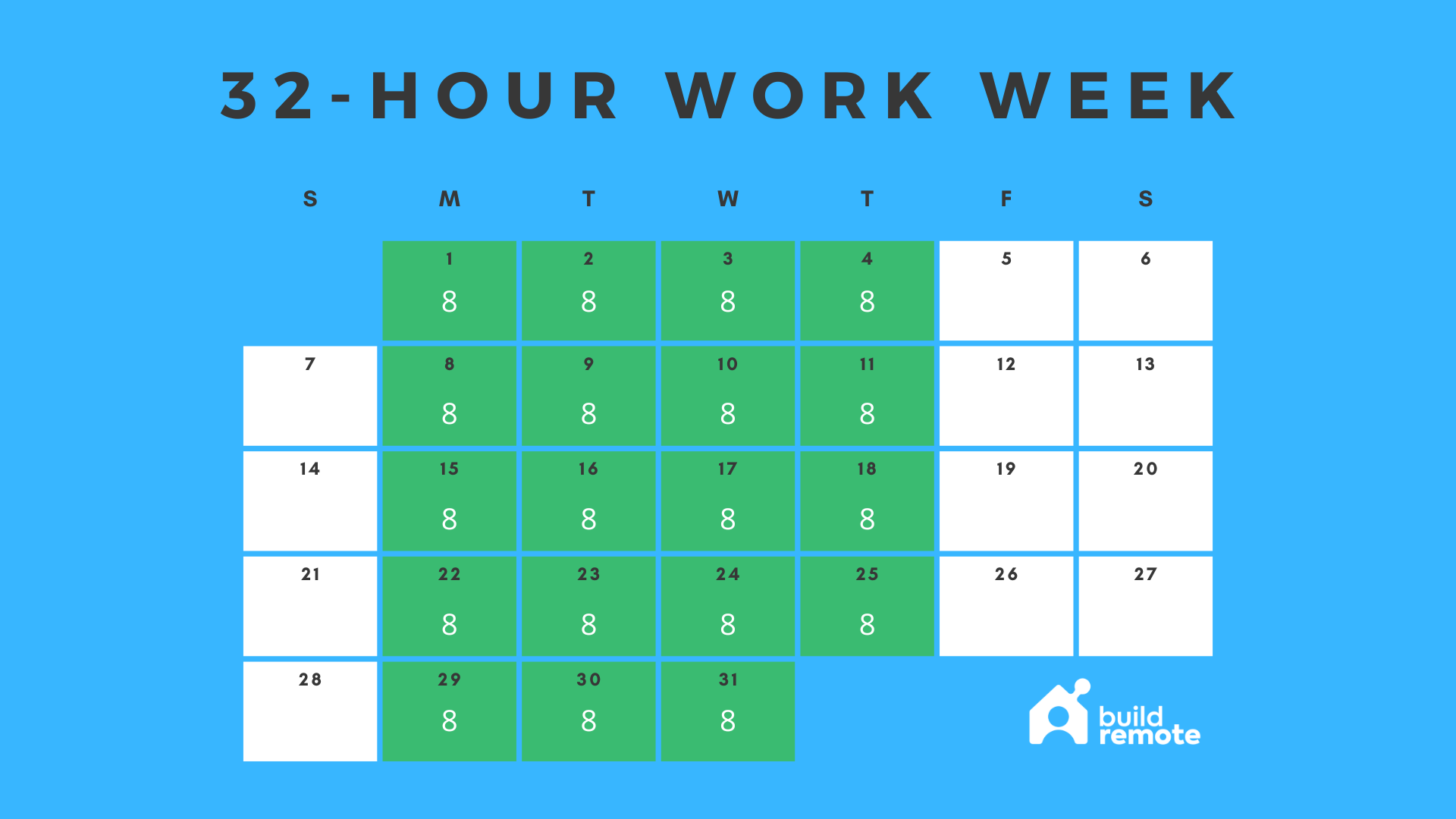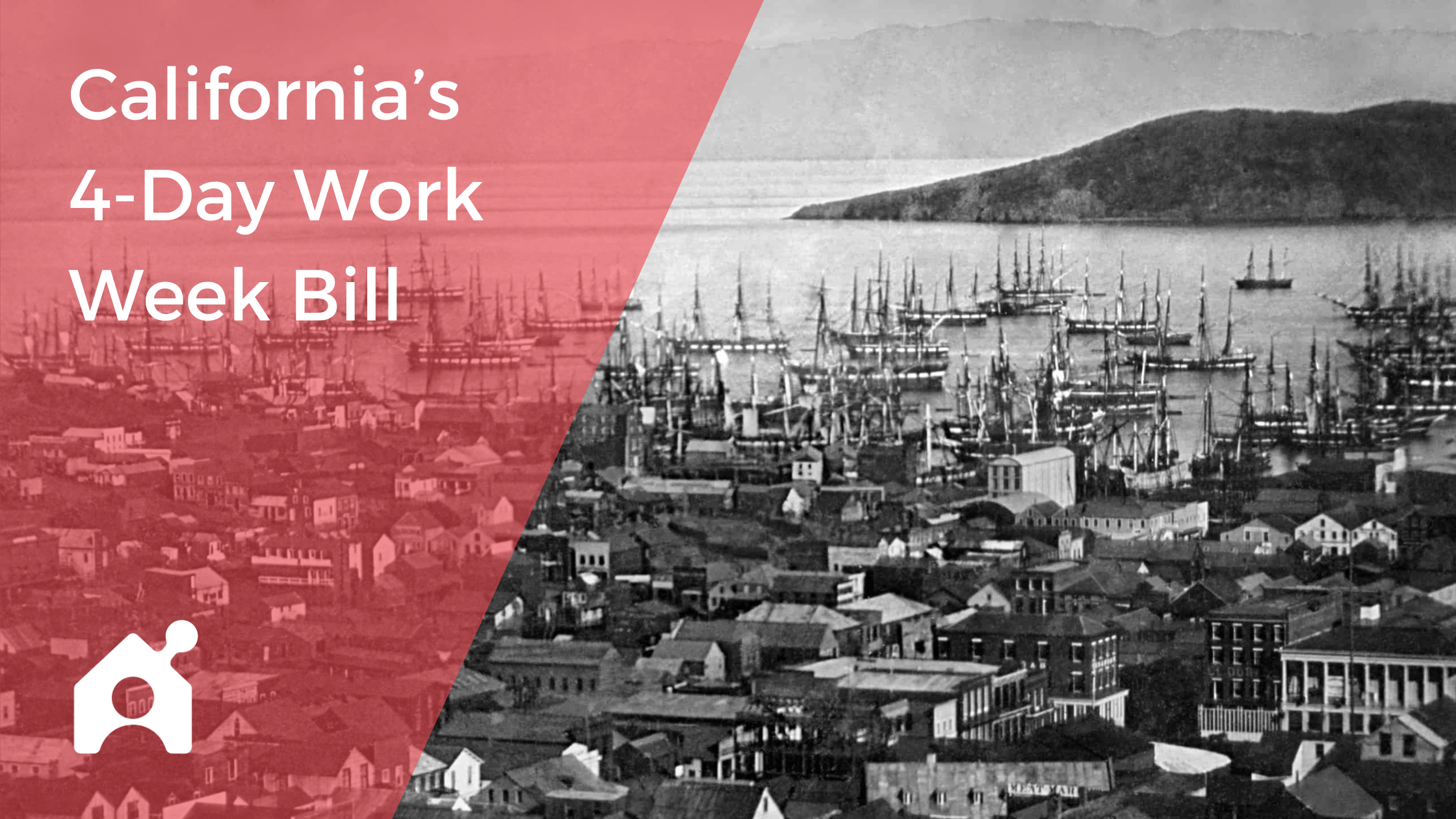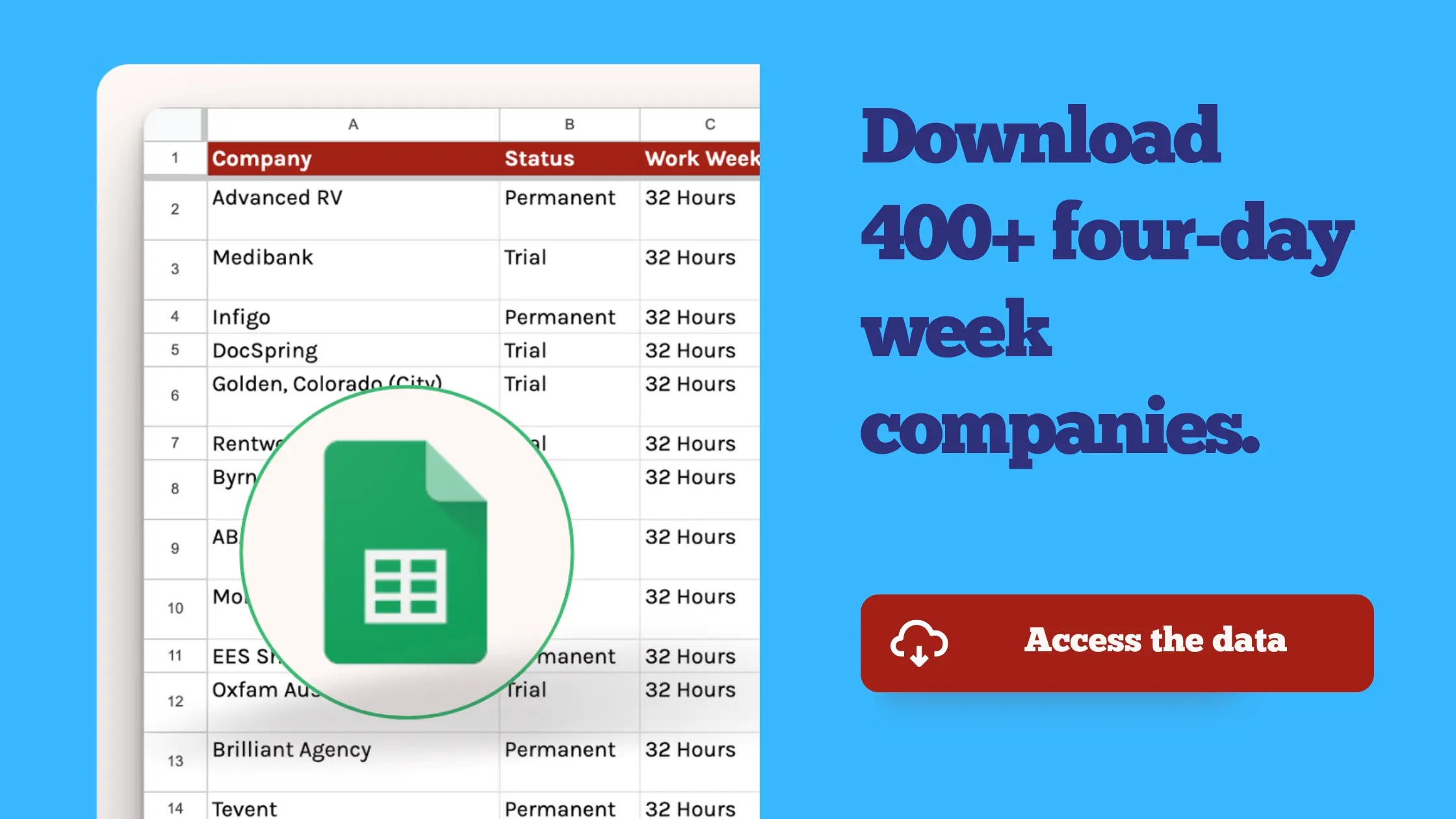The 32-Hour Work Week Moves Mainstream [Oct 2023]

What is a 32-hour work week?
The most common 32-hour work week is Monday – Thursday, eight hours per day. The 32-hour work week differs from the four-day work week which may consist of four 10-hour workdays. The 32-hour work week preserves the customary eight-hour workday; it simply features one fewer workday per week.
I’ve worked 32 hours per week since January 2020, first at a small, remote marketing agency and now here at Buildremote. At the marketing agency, we had worked a 36-hour week (half-day Fridays) for years before getting rid of Friday as a workday altogether. That brought us to a four-day (Monday-Thursday), 32-hour work week. Once we started, we never looked back.
While the 32-hour work week is nothing new for me, recent news has put the issue on the front burner for both employers and workers who may have never before given the idea much thought. The United Auto Workers (UAW) strike that began on September 14, 2023 features a 32-hour work week as a central demand, and proposals to make the 32-hour work week the standard have been introduced in both the California State Assembly and the U.S. Congress.
I’ve experienced the 32-hour work week as an individual contributor and seen how it works to the company’s benefit as well. In this article, you’ll read about everything I’ve learned working this schedule plus everything I’ve researched about the trend catching on around the world. Since we’ve already defined the 32-hour work week above, I’ll share the latest news first, then jump in from every angle.
Use the links below to jump to a section that interests you the most.
👉 32-Hour Work Week News 👈
There is a worldwide movement toward a 32-hour work week happening. Hundreds of companies have adopted a four-day week, countries are piloting trials, unions are demanding it, and bills are being proposed to shorten the work week. In addition, a recent Morning Consult survey found that 75% of workers favor a four-day work week, even though the survey stipulated a 40-hour work week compressed into those four days. It’s logical to assume that a four-day, 32-hour work week would have garnered even stronger support from survey participants.
In this section, we’ll keep you up-to-date on what’s happening with the 32-hour work week.
United Auto Workers (UAW) Demands The 32-Hour Week In Strike
In the ongoing (at this writing) UAW strike, a 32-hour work week is one of the central demands, in addition to better pay. The union’s stance is that autoworkers voluntarily took a haircut in the fallout of the Great Recession in 2008 to help automakers survive; since then, automakers’ profits have soared, and the UAW contends that it’s now time for the companies to share that prosperity with workers.
While a 32-hour work week is a big ask in a manufacturing context, where factories run round-the-clock, it turns out it’s not a new idea for the UAW. Nearly a century ago, a shorter work week was a goal for the union, as a continuation in a long-term struggle for shorter hours and better pay. When the Fair Labor Standards Act (FLSA) passed in 1938 establishing a 44-hour work week, and was amended in 1940 to a 40-hour work week, it was assumed that the fight would continue on to the next target, a 30-hour work week.
Ultimately, World War II intervened, and in the aftermath, union leaders dropped demands for a shorter work week, instead pushing for increased pay and other benefits.
While it’s impossible to predict the deal that the automakers and union will agree on, it is likely that the 32-hour work week will not be part of it, for the reason mentioned above. In factories running 24 hours per day, a shortened work week will require hiring additional workers—under the terms negotiated in the new union contract, making it a very expensive concession for the companies. Its inclusion in UAW demands is a reflection of members’ issues; many UAW workers are currently working 60 hours or more per week, leaving them little time for their families and personal lives.
It’s possible that the UAW ask is merely a bargaining chip to try to ultimately get overtime pay for hours in excess of 32 (or some other number below 40) worked each week. While this would not directly result in a shorter work week for autoworkers, it might result in sufficiently increasing pay so that they don’t need to work as many hours of overtime to make ends meet.
Only time will tell if the union succeeds at getting some concession related to the length of the work week or when overtime pay kicks in, but even if the UAW is unsuccessful this time, a shorter work week is likely to continue as a feature in future negotiations.
The Thirty-Two Hour Workweek Act (US) Proposes A Federal Change
The proposal to adopt the 32-hour work week in federal law (H.R. 4728) actually predates the introduction of California’s four-day work week bill, which has received more attention. Congressman Mike Takano of California first introduced the bill to amend the FLSA in July 2021. The bill failed to make it out of committee in the 117th Congress, but has been reintroduced in the current 118th Congress as H.R. 1332, where it is again not expected to be voted out of committee—though it did pick up more than a dozen additional sponsors, suggesting that passage might just be a long waiting game.
Takano’s bill would establish time-and-a-half pay for any hours in excess of 32 worked within a single week. The title of Takano’s proposal, “A bill to amend the Fair Labor Standards Act of 1938 to reduce the standard workweek from 40 hours per week to 32 hours per week, and for other purposes,” suggests that a legal standard exists, but as noted in a previous article, the 40-hour work week in the U.S. is the result of custom, not law. The FLSA stipulates only that any hours in excess of 40 worked in a single week be compensated at 1.5 times the regular hourly wage.
If adopted, H.R. 1332 would in effect change custom; it would not establish as federal law a standard work week. And, like the FLSA, its provisions would apply to hourly wage earners, not salaried employees—though if the customary work week changes for hourly workers, it’s likely to be adopted for salaried workers as well.
Takano’s proposal also does not change FLSA coverage; the act would continue to apply for all businesses with annual revenue of $500,000 or more, or that engage in interstate commerce. The proposal specifies a phase-in period: In the year beginning six months after passage, overtime pay would apply to any hours worked in excess of 38 per week. In the following year, overtime would apply to all worked hours over 36, falling to 34 in the subsequent year, and finally to 32 hours within five years of becoming law. Aside from the phase-in period and who is covered by the legislation, the California proposal to adopt a 32-hour work week closely mirrors this proposed amendment of the FLSA.
California Proposes A 4-Day Work Week Bill
The state of California recently gained more buzz with the introduction of a 32-hour work week bill. Like the proposal to amend the FLSA in Congress, the bill did not make it out of committee.
The failed bill, AB 2932, was introduced by Assembly members Evan Low and Cristina Garcia early in 2022’s legislative session. If passed, it would have amended Section 510 of the state’s labor code, reducing the standard 40-hour work week to 32 hours…for some workers.
This bill, like many other workplace-related changes we’ve seen, largely came out of shifts brought about by the pandemic. Many companies were forced to make dramatic adjustments to let their employees work safely, which in turn led to more independence and autonomy in workers. Not surprisingly, when some businesses started pushing a return to the traditional 40-hour, in-office workspace, people pushed back.
“[Employees] are sending a clear message they want a better work-life balance,” Garcia said of the bill, referencing the millions of workers who have left their jobs to find work that paid better, or allowed more flexibility.
In theory, legislators hoped this would lead to fewer working hours. By making overtime a more expensive proposition for employers, they may start requiring less of it. Best-case scenario, employees work less; worst-case scenario, they are paid more for the work they do. And indeed, many companies that have made the switch to the four-day work week notice that their employees can in fact get everything done in less time.
Like the proposal to amend the FSLA, AB 2932 would have only applied to California businesses with more than 500 employees—about 20% of the state’s workforce. Thirty-two hours would be considered a full work week for these employees. The bill did not permit companies to cut down wages. In practice, this means that salaried employees in companies covered by the law would continue to be compensated for the same salary they received when working a 40-hour week; hourly employees would be paid 1.5 times their hourly wage (“time and a half”) when working more than 32 hours in a week.
Companies that employ fewer than 500 could continue to operate as normal and pay overtime after their personnel work 40 hours. In addition, unionized workers would not see any changes.
The bill prompted an outcry from business owners, economists, and others. Nicholas Bloom, a professor of economics at Stanford University, anticipated many affected jobs and companies moving out of California and to Oregon or Nevada. Also against the bill was the California Chamber of Commerce, going so far as to call it a “job killer.”
To address these criticisms, Low introduced a bill to fund a pilot program in the 2023 Assembly session. It would provide grants for California employers who want to “test drive” a shorter workweek. Grant recipients would be required to report to the state’s Department of Industrial Relations the impact of the shorter work week on employee and employer satisfaction. So far this proposal has also failed to advance out of committee.
Although AB 2932 failed in the 2022 session, some prominent employers discussed it favorably, including Aziz Hasan, CEO of Kickstarter. “If our time and attention is focused as best as it can be in those four days,” he asks, “can we have a more potent impact on the things that we care about from a professional standpoint?” Despite the proposal’s failure to advance in the State Assembly, when taking political realities into consideration it’s more likely that a progressive state like California will adopt a 32-hour work week before such proposals gain serious traction at the federal level.
It’s also important to note that California is not the only state where bills to mandate or incentivize the 32-hour work week have been considered; Hawaii, Maryland, New York, Pennsylvania, and Washington have each had proposals introduced in statehouses in the past several years. And some local governments aren’t waiting for states to legislate a shorter work week; San Juan County, Washington, comprised of a group of islands 35 miles northwest of Seattle, debuted a 32-hour work week for most county employees on October 1, 2023.
While the idea for making the 32-hour work week the customary standard has just started to pick up steam in the U.S., a number of U.S. and global companies have already adopted it—and a number of other countries are either piloting the 32-hour work week or have already adopted it for some workers, as detailed in the following sections.
Companies Doing A 32-Hour Work Week
Every time a new company announces its new four-day work week policy, I update this list. It’s the most complete list of four-day, 32-hour companies on the internet. Here are a few of the biggest companies:
Basecamp
Basecamp, a company based in the United States, does a seasonal 32-hour work week. They started doing this in 2008.
“As I write this it’s the first week of May, and there’s an energetic buzz in the air — because it means that Summer Hours are about to start here at Basecamp. During summer, we work 4-day work weeks, aka ‘summer hours’. Summer hours are in effect from May 1 through August 31 each year.”
Microsoft Japan
Microsoft Japan, a company based in Japan, did a trial of a 32-hour work week in 2019.
“Workers at Microsoft Japan enjoyed an enviable perk this summer: working four days a week, enjoying a three-day weekend — and getting their normal, five-day paycheck. The result, the company says, was a productivity boost of 40%,” said Bill Chappell in an NPR article.
Shopify
Shopify, a company based in Canada, does a seasonal 32-hour work week. They started doing this in 2020.
In a tweet by Carl Rivera, VP of Product, said, “Today Shopify announced Fridays off for R&R through August. A response to lower rates of vacation being scheduled, despite the increased mental pressure from the changing times that we’re in. And, we also have no meeting Wednesdays (since before it was cool).”
Piktochart
Piktochart, a company based in the United States, does a permanent 32-hour work week. They started doing this in 2020.
“We believe that by prioritizing our people, we will be able to build better products and a successful, sustainable business for the long run. The 4 day work week is something that we see can help us to achieve our goals.”
thredUP
thredUP, a company based in the United States, does a permanent 32-hour work week. They started doing this in 2021.
“Did we mention that we are currently utilizing a 4 day work week to really emphasize the importance and value of work-life balance? When our team shows up for work, they are energized and motivated to succeed – all while being the most crucial piece to keeping the thredUP operations humming.”
Bolt
Bolt, a company based in the United States, does a permanent 32-hour work week. They started doing this in 2021.
“I believe a 4 day work week isn’t an “if” for most companies, it’s a “when.” In true Bolt spirit, we didn’t wait around to follow others – we put our money where our mouth is. I’m honored to lead the company this way and can’t wait to share the results along the way.”
Wonderlic
Wonderlic, a company based in the United States, does a permanent 32-hour work week. They started doing this in 2021.
“After reviewing the results of a successful 12-week summer trial, Wonderlic is fully instating a 32-hour, four-day work week, effective immediately.”
Kickstarter
Kickstarter, a company based in the United States, does a trial of a 32-hour work week. They started doing this in 2022.
“Kickstarter plans next year to test a four-day work week with some or all of its employees, though details of that remain to be figured out, including whether all workers will have the same schedule,” wrote Ina Fried for Axios.
Panasonic
Panasonic, a company based in Japan, does a permanent, optional 32-hour work week. They started doing this in 2022.
“Executives at some Japanese firms are reacting to the pandemic by adopting more flexible work arrangements. Those at Panasonic say they will allow their employees the option of scaling down to a 4-day week.”
See the full list of 4-day companies (and job openings) here.
Countries Doing A 32-Hour Work Week
This list is much smaller than the companies list, but potentially more impactful. Here are a few countries that have trialed or permanently adopted a 32-hour work week:
Iceland
Iceland did a “Trial 36 Hours” in 2015-2019
“The trials were conducted between 2015 and 2019, initiated by the Reykjavik City Council and the Icelandic national government. The trials ultimately involved 2,500 workers, more than 1 percent of the nation’s working population, who moved from working 40 hours a week to a 35- or 36-hour week, without a reduction in pay.”
Japan
Japan did a Recommendation in June 24, 2021
“The country’s annual economic policy guidelines, released this month, unveiled plans to push employers to adopt four-day workweeks, marking official acceptance of a once-fringe approach…”
Spain
Spain did a “Trial 32 Hours” in Proposed: September 1, 2021
“When the progressive party Más País launched in 2019, it included the 4-day work week as part of its platform, and went on to propose the trial that won the Spanish government’s approval in January. Although the specifics remain undecided, the pilot, which is expected to launch in September and last three years, will use 50 million euros in European Union funding to compensate an estimated 200 companies for reducing their employees’ work week to 32 hours—without cutting their salaries.”
Scotland
Scotland did a “Trial 32 Hours” in September 3, 2021
“Scotland plans to launch a trial four-day workweek. The decision was the culmination of a campaign promise made by the ruling Scottish National Party. Workers will have their hours reduced by 20%, but won’t suffer any loss in compensation. The program will be funded by the SNP with a £10 million fund ($13.8 million U.S.).”
Lithuania
Lithuania implemented the option for public-sector employees with children under the age of three to work 32 hours per week without a reduction in pay. The law took effect starting January 1, 2023.
“Lithuania is the latest country to try out a four-day workweek, thanks to a policy passed by lawmakers yesterday (April 21).
Under the new policy, which will take effect next year, public-sector employees with children under the age of three will be allowed to work 32 hours a week without any reduction in their pay. A standard workweek in Lithuania is 40 hours.”
See the full list of countries here.
👉 The 32-Hour Work Week Schedule 👈
Below, you’ll learn everything you need to know about the 32-hour schedule if you or your company were to make the switch.
Benefits of the 32-Hour Work Week
I use “four-day work week” and “32-hour work week” synonymously. By my calculation, I’ve experienced 22 benefits working this schedule (12 for employees, 10 for companies). Take a look at that article for an in-depth look at the benefits. I’ve included the most important ones here.
See Also:
- Short Working Week Schedule Options
- Average Work Hours Per Week For Every Country
- How Many Work Days Are In A Year?
For Individuals & Freelancers
- Work-life balance
- Increase in happiness
- Fewer meetings
- More time for personal use and development
- Lower cost for childcare
I wrote in more-depth about the benefits of a four-day work week for the individual here.
For Companies & Managers
- A way to attract talent
- Better employee retention
- Happier employees (less burnout)
- Cultural switch from measuring hours at work to output
- Press coverage
Read more about benefits for the company here.
If you’re a founder or manager at a company that is considering a switch to this work schedule, I recommend reading this article about how to implement it, step-by-step.
32-Hour Work Week Schedule Examples
4-Day Work Week
The most common 32-hour schedule is four work days (like Monday – Thursday) with eight hours per day. Essentially, Friday is removed altogether from a typical work week. I personally work this schedule now.
Summer Fridays
Summer Fridays (or the seasonal four-day work week) is the same schedule as above, but only used during the summer.
6.5 hours per day
Another way to get to 32 hours per week would be to remove 1.5 hours of work per day. By working 6.5 hours per day, you’d get to 32 hours of work over the normal five weekdays. I haven’t heard of company schedules of 6.5 hours per day, but I have heard about six-hour workdays.
Similar schedules
If you’re looking for other ideas, these alternative work schedules are similar (although not the same amount of hours):
- 4-10: Four, 10-hour work days per week
- 9/80: 80 hours over two weeks, with every other Friday off
- 9/72: Eight-hour workdays with every other Friday off
- Half-day Friday: Eight-hour workdays on Monday – Thursday, then four hours on Friday.
- 3-day work week
Read about 29 alternative or compressed schedules.
Where To Find 32-Hour Work Week Jobs
Flexjobs
The first place I’d look is Flexjobs, the world’s biggest job board for remote and flexible work. You’ll find dedicated filters to “flexible” and “alternative” schedules.
Search for 32-hour work week jobs on Flexjobs.
Other options
- Indeed: This is the biggest job board in the world. Although they aren’t focused on alternative jobs, they’ll have most or all of the 32-hour jobs available.
- 4dayweek.io: This job board focuses on remote, 32-hour jobs in software.
- Every 4-day company: I have this running list of all four-day companies and a link to find jobs at those companies.
Try it out
We’ve worked the 40-hour week since Henry Ford switched Ford Motors to that schedule almost 100 years ago. That doesn’t mean it fits for today. Do you think you and your team can get the same amount of work done in 32 hours as you do 40? Then give the alternative schedule a try.
Find a better work week on Flexjobs.
View other unique work week schedulesThis is part of our series highlighting unique work schedules. Have a look:
|
Some of the links in this article are affiliate links that may provide Buildremote with a small commission at no cost to you.




